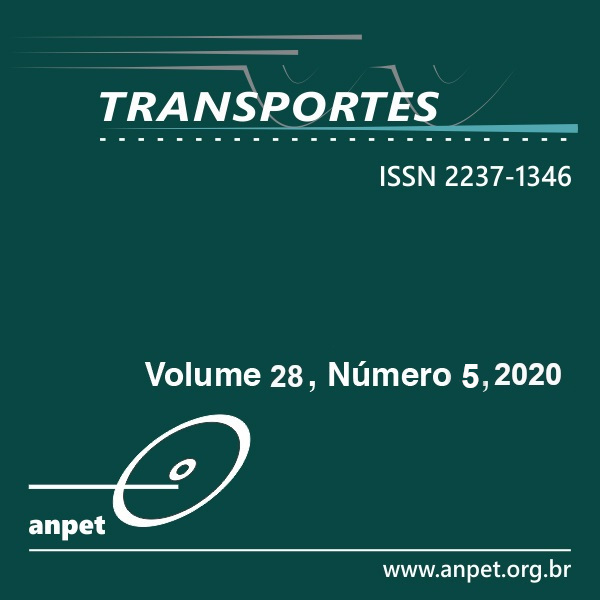Econometric study of the effects of credit availability on air transport demand in Brazil
DOI:
https://doi.org/10.14295/transportes.v28i3.1898Keywords:
Demand. Consumption. Air transportation. Econometrics.Abstract
Greater availability of credit has the potential effect of boosting consumption in an economy, at least in the short and medium terms. In the case of air transportation, it may stimulate the payment for airline tickets in installments, thus attracting new, lower-income consumers and leveraging a larger number of trips by the existing ones. Additionally, national companies and corporations - potentially favored with higher working capital - may, in theory, spend more on corporate travel. This paper develops an empirical model to test the impact on air transport demand of the higher amount of available credit in the Brazilian economy in the late 2000s. Using statistical data obtained from the National Civil Aviation Agency, we utilized a panel data set of Brazilian city-pairs to estimate an econometric model of air travel demand employing an instrumental variables estimator. With this approach, we were able to test the hypothesis of credit availability in the local economy as one of the explanatory factors of the Brazilian commercial aviation demand in the period.Downloads
References
ANAC. (2016) 10 anos - Agência Nacional de Aviação Civil. 1st. ed. Brasília: ANAC, 195 p.
Bacchetta, P. e Gerlach, S. (1997). Consumption and credit constraints: International evidence. Journal of Monetary Economics, v. 40, n. 2, p. 207-238. DOI: 10.1016/S0304-3932(97)00042-1.
Belloni, A., Chen, D., Chernozhukov, V. e Hansen, C. (2012). Sparse models and methods for optimal instruments with an ap-plication to eminent domain. Econometrica, v. 80, n. 6, p. 2369-2429. DOI: 10.3982/ECTA9626.
Boonekamp, T., Zuidberg, J. e Burghouwt, G. (2018). Determinants of air travel demand: The role of low-cost carriers, ethnic links and aviation-dependent employment. Transportation Research Part A: Policy and Practice, v. 112, p. 18-28. DOI: 10.1016/j.tra.2018.01.004.
Borça Jr., G. e Guimarães, D. (2015). Impacto do ciclo expansionista de crédito à pessoa física no desempenho da economia brasileira 2004-2013. Revista do BNDES, n. 43, p. 157-159.
Jorge-Calderón, J. D. (1997). A demand model for scheduled airline services on international European routes. Journal of Air Transport Management, v. 3, n. 1, p. 23-35. DOI: 10.1016/S0969-6997(97)82789-5.
Cawley, G. C. e Talbot, N. L. (2010). On over-fitting in model selection and subsequent selection bias in performance evalua-tion. Journal of Machine Learning Research, v. 11, p. 2079-2107.
Di Maggio, M. e Kermani, A. (2017). Credit-induced boom and bust. The Review of Financial Studies, v. 30, n. 11, p. 3711-3758. DOI: 10.1093/rfs/hhx056.
Galeano, E. V. e Feijó, C. (2012). Crédito e crescimento econômico: evidências a partir de um painel de dados regionais para a economia brasileira nos anos 2000. Revista Econômica do Nordeste, v. 43, n. 2, p. 201-220.
Gall, N. (2008) A festa do crédito e a economia mundial: Dinheiro, ganância, tecnologia. Braudel Papers, n. 43.
Grosche, T., Rothlauf, F. e Heinzl, A. (2007). Gravity models for airline passenger volume estimation. Journal of Air Transport Management, v. 13, n. 4, p. 175-183. DOI: 10.1016/j.jairtraman.2007.02.001.
Kazda, A. e Caves, R. (2015) Airport Design and Operation. 3a. ed. Bingley: Emerald Group Publishing Limited. 569p.
Kohavi, R. (1995). A study of cross-validation and bootstrap for accuracy estimation and model selection. In International Joint Conference on Artificial Intelligence, v. 2, p. 1137-1143.
Maddala, G. S. e Lahiri, K. (1992). Introduction to econometrics, v. 2. New York: Macmillan.
Olney, M. L. (1999). Avoiding default: The role of credit in the consumption collapse of 1930. The Quarterly Journal of Eco-nomics, v. 114, n. 1, p. 319-335. DOI: 10.1162/003355399555927.
Sant'Anna, A. A., Borça Jr., G. e Araujo, P. Q. (2009). Mercado de crédito no Brasil: evolução recente e o papel do BNDES (2004-2008). Revista do BNDES, v. 16, n. 31, p. 58-59.
Soman, D. e Cheema, A. (2002) The effect of credit on spending decisions: The role of the credit limit and credibility. Market-ing Science, v. 21, n. 1, p. 32–53. DOI: 10.1287/mksc.21.1.32.155.
Valdes, V. (2015). Determinants of air travel demand in Middle Income Countries. Journal of Air Transport Management, v. 42, p. 75-84. DOI: 10.1016/j.jairtraman.2014.09.002.
Wooldridge, J. M. (2016). Introductory econometrics: A modern approach. Nelson Education.
Downloads
Published
How to Cite
Issue
Section
License
Authors who submit papers for publication by TRANSPORTES agree to the following terms:
- The authors retain the copyright and grant Transportes the right of first publication of the manuscript, without any financial charge, and waive any other remuneration for its publication by ANPET.
- Upon publication by Transportes, the manuscript is automatically licensed under the Creative Commons License CC BY 4.0 license. This license permits the work to be shared with proper attribution to the authors and its original publication in this journal.
- Authors are authorized to enter into additional separate contracts for the non-exclusive distribution of the version of the manuscript published in this journal (e.g., publishing in an institutional repository or as a book chapter), with recognition of the initial publication in this journal, provided that such a contract does not imply an endorsement of the content of the manuscript or the new medium by ANPET.
- Authors are permitted and encouraged to publish and distribute their work online (e.g., in institutional repositories or on their personal websites) after the editorial process is complete. As Transportes provides open access to all published issues, authors are encouraged to use links to the DOI of their article in these cases.
- Authors guarantee that they have obtained the necessary authorization from their employers for the transfer of rights under this agreement, if these employers hold any copyright over the manuscript. Additionally, authors assume all responsibility for any copyright infringements by these employers, releasing ANPET and Transportes from any responsibility in this regard.
- Authors assume full responsibility for the content of the manuscript, including the necessary and appropriate authorizations for the disclosure of collected data and obtained results, releasing ANPET and Transportes from any responsibility in this regard.










